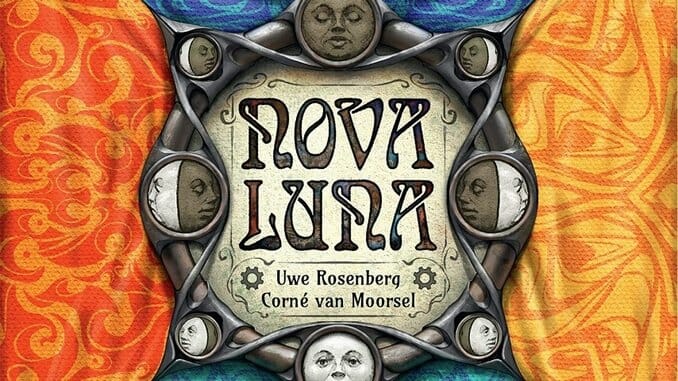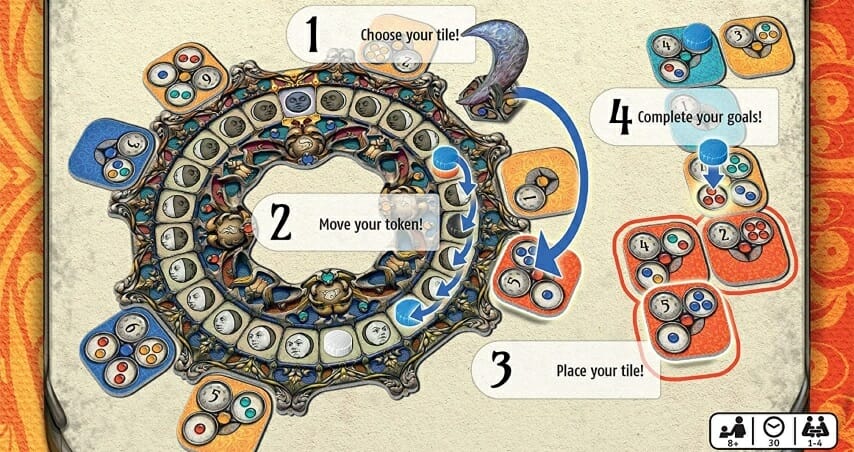
Nova Luna was one of the three nominees for this year’s Spiel des Jahres (Game of the Year) award, losing out to the party game Pictures in that category. (The Kennerspiel des Jahres award, given to the expert’s or connoisseur’s game of the year, went to The Crew, which I reviewed here in June.) It’s a reboot of an earlier game from 2016 called Habitats, but simplifies the rules and changes to an abstract theme that produces easier, quick gameplay that combines short turns with a long-term puzzle.
Nova Luna is a simple tile-laying game at its core. You will select one tile on each turn and add it to the tiles you’ve already laid in front of you. Just about all of the tiles in the game have one to three goals on them that are based on what tiles are adjacent to it. When you’ve placed the required tiles next to that one to satisfy a goal, you place one of your 20 tokens on that goal. The first player to place all 20 of their tokens wins the game.
11 tiles are placed randomly around the rondel, with the twelfth space occupied by a marker. On your turn you may take any of the next three tiles in front of the marker, skipping any empty spaces. The rondel doesn’t refill until there are zero or one tiles remaining. Each tile has a number on it from one to seven, and you move your token around the track on the rondel that many spaces. After the first round of turns, the player whose token is the furthest behind gets to take the next tile—and thus may take consecutive turns if they’re far enough behind and choose tiles with low numbers, while it’s possible for one player to have to wait for all other players to select twice until they get to choose again.

The tiles come in four colors, and those goals revolve around the colors of adjacent tiles. The goals are straightforward; they say that you have to have from one to four tiles adjacent to that one in specific colors—one red, a teal and a yellow, three dark blues, etc. The tiles are square-ish, so in theory, you’d have just four sides to play with, so many of the goals you see on tiles would be incompatible—completing one goal might make another one impossible. For example, you might put a yellow and a dark blue next to a tile to complete one goal, but if that tile has a goal of three reds, that shouldn’t be possible.
The twist here is that you can chain tiles of the same color to satisfy a goal. That goal of three reds can be fulfilled by putting three tiles next to the tile with that goal on it, but you can also put one red tile next to it, and then attach two more red tiles to that first one to create a contiguous chain of three reds, and that also would fulfill the goal. As far as I can tell, there are no tiles in Nova Luna with goals that are incompatible as long as you use chains.
This means there are unfinished goals still in play much longer in Nova Luna than they might otherwise be, and thus one of the challenges you will face is deciding when to give up on a goal, or place something that will truly make a goal impossible. The temptation of a goal that’s still technically feasible looms large over game play, and the real skill is evaluating the goals in front of you to determine the most efficient ways to fulfill multiple goals with a few tile plays. By the time you’re near the end, each tile you place should fulfill two or even three goals, which means the pace of the game seems to accelerate as you go.
Nova Luna takes about a half an hour to play once everyone knows the rules, maybe 40 minutes if you’ve got four players, and is definitely suitable for players eight and up. The abstract theme really works in the game’s favor, I think; I haven’t played Habitats, but having read the rulebook, it was far more complicated from tile selection to scoring. This strips the earlier game down to its core mechanics, in a good way, removing some needless complexity and reducing the learning curve. It’s a very good, light, family-friendly game that might lack the upside of some of Rosenberg’s other titles but still has solid replay value.
Keith Law is the author of The Inside Game and Smart Baseball and a senior baseball writer for The Athletic. You can find his personal blog the dish, covering games, literature, and more, at meadowparty.com/blog.